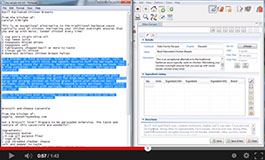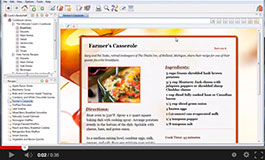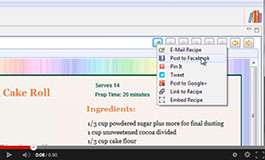The Scoop on Cauliflower and Dark Spots

Since we’ve all had the experience of our cauliflower developing brown or black spots on its pretty white head, and since we have a LOT of new cooks receiving the Cook’n Newsletter, I thought I’d address what these spots mean and what we should do about them. (Maybe some of our more seasoned cooks wonder about this issue as well?)
But first, did you know that the individual tiny nubbies on cauliflower are called CURDS? Me neither. And a group of curds is a floret. This is according to the International Produce Training site. And these folks are my source for the answer to the above question. Here’s their information on cauliflower and those developing dark spots:
“Discolored curds is the most common cauliflower defect you will find. This discoloration is a result of oxidation. The longer the cauliflower is stored, the more likely the curds will oxidize, and discolor. The discoloration will appear in different stages, first appearing as a light tan or brown, then advancing in size and the color will change to a dark brown to black in color.

See What Cook'n Can Do
“While the discoloration is harmless, it’s a signal that decay is starting. These spots are eventually accompanied by the cauliflower turning yellow and developing soft, mushy curds.” The Produce Training site also explains that brown spots on cauliflower have likely resulted from moisture or condensation on the cauliflower. Their advice? If the rest of the cauliflower is fine, just scrape these off. OK, good to know. And this is what I’ve always done anyway, but the validation from the pros is always nice.
Now on to another cauliflower-related subject: It’s one of the most versatile vegetables around and is so tasty, when prepared well. But because it’s a cruciferous plant (high sulfur content), it’s easy to mis-cook it.
There are lots of ways to cook cauliflower—roasting, baking, pan-frying, stir-frying, and steaming. Let’s talk about steaming since this is the most common way of cooking cauliflower, and this is the most common way of mis-cooking it, too. Folks tend to steam it too long and when they do, they end up with a sulfury-smelling mush.
Steaming can be done in a pan, in a steamer basket, and in a microwave.

First, the pan: This is a favorite way to steam cauliflower. One dish, real steam, great tasting cauliflower. Bring about 1/4 inch of water to a boil in a large frying pan. Add about 1/2 tsp. salt and trimmed and cleaned cauliflower florets. Cover and steam about 3 minutes for crisp-tender and up to 6 minutes for completely cooked, soft florets. Longer cooking generally results in the above-mentioned mush.

Next, the steamer basket: Bring about an inch of water to a boil in the bottom of a pot into which your steamer basket or insert fits. Put trimmed and cleaned cauliflower florets in the steamer basket, set over the boiling water, cover, and steam until tender to the bite, again about 3 for crisp-tender and up to 6 minutes for fully tender florets.

Last, the microwave: (While this method is certainly quick and convenient, it must be noted, however, that it is more difficult to get vegetables steamed to a precise and even level of done-ness.) Put freshly washed cauliflower florets with water still clinging to them in a large bowl, a small pool of water should form in the bottom of the bowl quite quickly. If you don't see water in the bottom of the bowl, add a tablespoon of water. Cover the bowl with a microwave-safe lid or plate (avoid plastic wrap in microwaves), and cook on high power for 1 minute. Test for tenderness and repeat at 30-second intervals until the cauliflower is steamed to your liking. Cauliflower steamed in a microwave may require a bit of draining or drying depending on how much liquid you used and how powerful your microwave is.
Cooking it right is just the beginning. Let’s talk flavor companions. We all like it in cheese sauce, but have you tried it with pesto? And cooks all over are teaming it up with curry. I love it with fresh garlic. But one of the best flavor combinations we’ve had lately is cauliflower with mint. Delicious!

Finally, as mentioned earlier—cauliflower is so versatile. It makes an incredible replacement for mashed potatoes—mashed cauliflower is divine. And we recently had it breaded and fried—cauliflower fritters was the side dish that won the day. Our hostess said they took her about 30 minutes total to make. She steamed one head of cauliflower (trimmed and cut into small florets) until the florets were very tender, but not mushy. After they cooled she combined them with one egg and mixed in about two tablespoons of flour and some salt (about 1/4 teaspoon). She mashed this all together and formed patties. She fried them in butter.
So don’t let those little brown/black spots deter you—scrape ‘em off . Then however you cook it, cook it right, and have fun experimenting with flavor combinations and cooking techniques!
Download Cook’n to get more amazing, kitchen-tested recipes and tips like this!
- ww.ipt.us.com
- www.ohhappybelly.com
- www.localfoods.about.com
- www.thekitchn.com
 Alice Osborne
Alice Osborne
Weekly Newsletter Contributor since 2006
Email the author! alice@dvo.com












